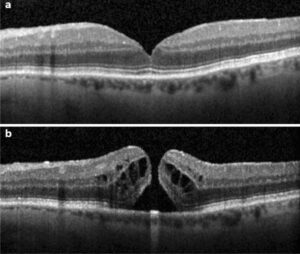What is a Retinal Tear/Detachments?
Retinal tears occur when the thin, inner lining of the eye develops a “rip” or defect, such as a hole or tear. These tears can be relatively asymptomatic or can cause a significant increase in flashes and/or floaters. If you are experiencing symptoms of new flashes or floaters, it is highly recommended that you call your ophthalmologist for an evaluation.
If left unattended, it is possible for a retinal tear to progress to a retinal detachment; in which, the layer of retina is separated from the inner eye. When this occurs, patients typically describe a veil or curtain obscuring their vision, or a progressive loss and/or darkening across their field of vision. If you experience these symptoms, it is imperative that you inform your eye doctor as soon as possible.
What Causes a Retinal Tear or Detachment?
There are numerous ways that a retinal detachment can occur. High-risk factors include …
- rheg
- serous/exudative
- trac
How Are Retinal Tears or Detachments Detected?
During a dilated pupil exam, your provider will perform a thorough exam of your retina. This might include using an “scleral depressor” to gently apply pressure on the outside of your eye so that your eye doctor is able to see all areas of your retina. If a retinal tear is observed during exam, a retina specialist can immediately apply laser to the affected area during your visit. This is to secure the area around a tear and prevent a retinal detachment from occurring.
In the event that a retinal detachment is noted, your retinologist can determine whether in-office treatment is possible, or if the retinal detachment requires surgical intervention. If your doctor decides that you are a candidate for in-office treatment, this process would include a pneumatic retinopexy, in which a gas bubble is injected into the eye to flatten the detached retina. In such an instance, the patient would have to continue multiple office to make sure the condition is stable and resolving. If the case cannot be fixed in the office, there are multiple surgical options to repair your retinal detachment.
 |
How Are Retinal Tears or Detachments Treated?
Treatment for Retinal Tears
-
- Focal Laser Treatment involves using a high-energy beam to surround the affected area, this effectively glues and sticks the tear down to prevent a larger tear or retinal detachment from forming. This in-office procedure is fast and effective in treating the tear, however, continued monitoring is advised afterwards, as the risk of developing another tear remains. (Read more about increased flashes and floaters.)
- Cryotherapy is often used for tears, or even detachments, that cover a larger area. This treatment is also performed in the office and uses a freezing probe to seal the affected area. Similarly to laser treatment, long-term observation is recommended.
-
- There are also cases in which the retinal tears or holes are small enough to self-seal and do not require intervention. In any case, it is important to maintain follow-up appointments if you have had a retinal tear.
Treatment for Retinal Detachments
Though most retinal detachments while require surgical intervention, in some cases, your retina specialist could consider the following in-office treatments:
-
- Laser Demarcation using the focal laser treatment discussed above. If a retinal detachment is far enough from the center of the vision, it is possible to isolate the detached area with laser. However, there is still a possibility of re-detachment through the patient’s lifetime.
- Pneumatic Retinopexy is an office procedure involving placing a small gas bubble in the eye, in conjunction with laser treatment, to flatten and attach the retina back down.
- Finally, while surgery might be necessary to repair the detachment, another important objective in treating any type of detachment is re-detachment prevention. Therefore, there are many options for your surgeon to consider for your situation. A standard surgical approach for most detachments includes the surgeon performing a vitrectomy, placing a gas bubble, and applying laser to weakened areas of the retina. However, it is possible that your surgeon could determine a need for further surgical support, such as using a scleral buckle, or temporary silicon oil fill, to best treat your individual case.
Do you have questions regarding retinal tears or detachments Call us today! (561) 499-8830
Learn more about Retinal Tears/Detachments:
American Society of Retina Specialists. Retinal Tear.

